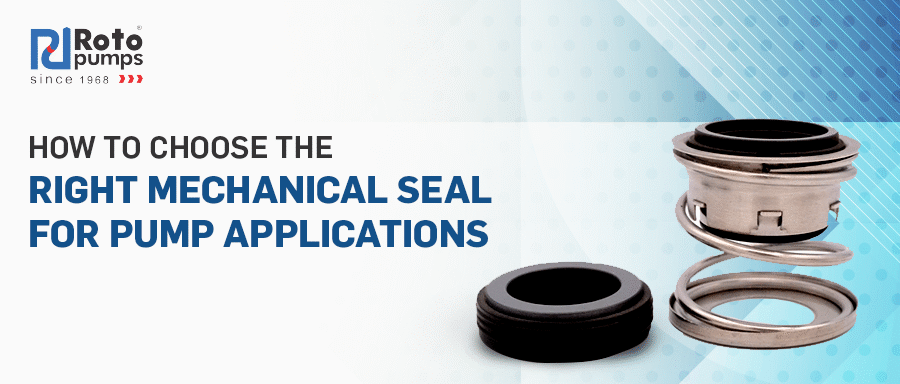Introduction: The Heart Of Leak-Free Performance
Mechanical seals are precision-engineered sealing components critical to the reliability and operational efficiency of rotating equipment such as pumps, compressors, and agitators. Unlike traditional gland packing methods, mechanical seals offer superior sealing capabilities by eliminating leakage, significantly enhancing equipment longevity and minimizing maintenance demands.
- How Mechanical Seals Work: Principle and Core Components
Mechanical seals operate fundamentally by maintaining constant contact between two meticulously polished surfaces:
Rotating Seal Face (Primary Ring): Mounted on the rotating shaft; dynamically balanced to reduce vibration.
Stationary Seal Face (Mating Ring): Fixed in the housing; provides a stable sealing surface.
The seal faces are held tightly together through spring pressure, hydraulic load, and other engineered forces, forming an efficient, dynamic seal that withstands diverse operating conditions.
- Mechanical Seal Design Classifications
- Balanced and Unbalanced Seal Design
Balanced Seal: A balanced seal reduces the contact pressure between seal faces by limiting the hydraulic load acting on them. This enables the seal to operate at higher pressures, generate less heat, and extend seal life. A seal is considered balanced when the balance ratio is less than 100%, meaning less of the pumped fluid pressure acts directly on the seal face.
Example: Handling light hydrocarbon condensates in upstream oil operations, where vapor pressure is high and fluid lubricity is low. Hot oil transfer in refinery, where balanced seals withstand high temperatures and pressures.
Unbalanced Seal: An unbalanced seal allows full hydraulic pressure to act on the seal face. This occurs when the balance ratio is 100% or more, resulting in higher face loading. These seals are simpler and typically used in low-pressure, clean-fluid applications where the risk of wear or thermal stress is minimal.
Example: Pumping treated water or polymer-injected water in enhanced oil recovery systems.
- Rotating vs. Stationary Seal Heads
Rotating Seal Head: tThe seal face rotates along with the shaft. It is suitable for low-speed applications where shaft misalignment, deflection, and dynamic forces are minimal. The simpler construction and lower inertia make it cost-effective and reliable under steady operating conditions.
Example: Low-speed sludge transfer in wastewater treatment, where shaft deflection is minimal and flow is steady.
Rule of Thumb: When the shaft surface speed exceeds 25.4 m/s, a stationary seal is recommended. At higher speeds, a rotating seal face is more prone to distortion and instability, which can lead to premature failure. Stationary seal heads offer greater sealing reliability under such dynamic conditions.
Stationary Seal Head: The seal face is fixed, and the mating ring rotates. This configuration is ideal for high-speed shafts or conditions involving greater mechanical stress, vibration, or misalignment.
Example: Chemical dosing pumps operating at high speed, or twin-screw pumps used in marine fuel transfer where shaft speeds are high and consistent sealing is critical.
- Single Spring vs. Multiple Spring Designs
The selection between single spring and multiple spring mechanical seals depends on factors such as space limitations, nature of the pumped fluid, and ease of maintenance.
Single Spring Seals: These seals are typically used in conjunction with bellows-type seals to load the seal faces. Their open design makes them less prone to clogging, making them ideal for slurry, viscous, or fibre-laden fluids. The larger spring coil also makes cleaning and inspection easier.
Example: Crude oil with wax/paraffin content, where solid particles may clog compact spring designs.
Multiple Spring Seals: It features several smaller springs evenly distributed around the shaft. These are more compact in axial length and provide uniform face loading. Their design is ideal for clean fluids and higher-speed applications.
Example: Food-grade syrup or concentrate beverage transfer, where hygiene and precision matter.
Advantages of Mechanical Seals
Mechanical seals offer several key advantages that directly impact operational efficiency and cost-effectiveness:
- Near – Zero Leakage Performance: Significantly reduced fluid leakage, improving environmental safety and regulatory compliance.
- Superior Reliability: Exceptional capability to operate under challenging environments including extreme temperatures, corrosive fluids, and varying pressures.
- Reduced Wear and Maintenance: Limits mechanical wear on pump shafts, sleeves, and bearings, drastically reducing maintenance intervals and associated downtime.
- Longer Equipment Lifespan: Enhanced durability and controlled operating conditions prolong equipment and seal life.
- Safely handle Hazardous Fluids: Particularly beneficial in sealing aggressive, hazardous, toxic, or radioactive fluids, providing enhanced safety and environmental protection.
Practical Limitations
Despite their substantial benefits, mechanical seals require specific considerations for optimal application:
- Higher Initial Cost vs. gland packing.
- Requires Expert Installation and alignment.
- Sensitive to Improper Handling during assembly or commissioning.
Mechanical Seals Classifications
- Internal / External Mounted Seals
Internal Mounted Seals: This is the most common sealing arrangement, wherein the liquid under pressure works in conjunction with the spring load to maintain consistent contact between the seal faces. This ensures effective sealing performance, simplicity, and operational efficiency.
Example: Internally mounted seals are used in municipal wastewater pumps for effectively managing varied highly viscous sludge, chemicals and dewatering application
External Mounted Seals: Primarily used in applications involving low pressure, external seals are advantageous in scenarios where corrosion or chemical reactions might occur if the seal’s metal parts are directly exposed to the sealed fluid. Such external mounting shields sensitive seal components from aggressive or corrosive liquids.
Example: It is used in acidic chemical transfer processes.
- Double Seals Configuration
Back to Back Double Seals – It consist of two single seals arranged back-to-back, with their primary seal faces oriented in opposite directions within the stuffing box. A neutral barrier fluid—maintained at a pressure higher than the pumped fluid—is circulated between the seals. This fluid lubricates the seal faces and prevents the process fluid from escaping to the atmosphere or entering the seal chamber.
The inboard seal (process side) retains the pumped fluid, while the outboard seal (atmospheric side) contains the barrier fluid, ensuring no loss of the neutral liquid and providing an extra layer of protection.
Example: Commonly used in the Oil & Gas industry for handling hazardous liquids in open or closed drain applications, as well as in knock-out drum pump systems, where external mounting helps protect seal components from corrosive or contaminated fluids.
Tandem Seals –It consist of two single seals mounted face-to-face in the same direction. A neutral buffer fluid is circulated between the inner (inboard) and outer (outboard) seals. The inboard seal handles the pumped process fluid, while the outboard seal retains the buffer fluid and blocks any potential leakage to the atmosphere. In some systems, this buffer fluid is circulated to absorb heat and cool the seal chamber.
Example: Tandem seals are widely used in pumps handling ammonium nitrate emulsions or solvent-based explosive liquids. These fluids are highly flammable or reactive, and even minor leakage can pose severe safety risks. The tandem seal arrangement ensures that any potential leak is contained within a buffer zone, drastically reducing the risk of ignition or operator exposure.
Material of Construction
Appropriate material selection significantly influences the performance, durability, and compatibility of mechanical seals:
- Primary Ring: Materials include carbon (for general applications), metal-filled carbon (for improved durability), tungsten carbide (excellent wear resistance), and silicon carbide (exceptional corrosion and abrasion resistance).
- Mating Rings: Typically made of ceramic or tungsten/silicon carbide, providing excellent durability, hardness, and resistance to wear.
- Elastomeric Components (‘O’ Rings & Bellows): Choices include nitrile, ethylene propylene (EPDM), and chloroprene, selected based on chemical compatibility, temperature range, and pressure conditions.
- Metal Bellows & Hardware Components: Typically fabricated from stainless steel or nickel-based alloys, offering superior strength and corrosion resistance.
Seal Support Systems API Plans
API seal flush plans are implemented to control the environment around mechanical seals, ensuring proper lubrication, temperature regulation, and contamination prevention — all of which significantly enhance seal life, performance, and safety, especially in demanding pump applications.
- API Plan 02 – Dead-End Seal Chamber
Description: No flushing or circulation; the seal chamber remains stagnant.
Example: Used in PCPs pumping clean water in non-critical applications with stable conditions.
- API Plan 11 – Discharge Recirculation to Seal Chamber
Description: Fluid is taken from the pump discharge and routed back to the seal chamber to flush and cool the seal.
Example: Twin screw pumps transferring lube oil or diesel, where clean fluid is available and thermal control is needed.
- API Plan 13 – Seal Chamber to Suction Recirculation
Description: Fluid flows from the seal chamber back to the suction side, reducing chamber pressure.
Example: PCPs handling high-viscosity fluids or slurries, to avoid pressure build-up in the seal area.
- API Plan 31 – Cyclone Separator with Clean Flush
Description: A cyclone removes solids from discharge fluid before it enters the seal chamber.
Example: Sludge or biomass slurry pumps (PCPs), where abrasive particles can damage seal faces.
- API Plan 32 – External Clean Flush to Seal Chamber
Description: Injects clean fluid from an external source to the seal chamber.
Example: Chemical transfer pumps or twin-screw pumps in paint plants, where process fluid is too aggressive or contaminated.
- API Plan 62 – Atmospheric Side Quench
Description: Steam, air, or liquid is applied to the atmospheric side of the seal to prevent coking or icing.
Example: PCPs handling hot polymers or sticky fluids that may solidify on the outer face.
- API Plan 54 – Pressurized Barrier System for Double Seals
Description: A closed-loop external system supplies clean, pressurized barrier fluid between double seals.
Example: Twin screw pumps in hazardous chemical or explosive liquid service, ensuring zero process leakage.
Mechanical Seal Selection Process– A Step-by-Step Guide
Follow these key steps to ensure proper mechanical seal selection based on application demands, fluid properties, and system conditions:
- Define operating conditions: temperature, pressure, shaft speed.
- Analyze fluid properties: corrosiveness, abrasiveness, volatility.
- Choose seal type: single, double, cartridge, or split.
- Select seal face material: based on lubricity and wear.
- Match elastomers: for chemical and temperature compatibility.
- Balance vs. unbalanced: match pressure and media characteristics.
- Configuration choice: internal/external, rotating/stationary.
- Pick API Plan: based on contamination, temperature, and pressure.
- Verify installation & maintenance needs: cartridge seals for ease of installation.
Take Away
Mechanical seals have become an essential technology for achieving reliable, leak-free performance in modern pumping systems. Their ability to handle a wide range of fluids—including corrosive, abrasive, toxic, and high-temperature media—makes them indispensable across industries like oil & gas, wastewater, chemicals, and food processing. By understanding the principles of seal operation, design types, API flush plans, and the seal selection process, engineers can ensure optimal sealing performance, reduced downtime, and enhanced equipment lifespan. With proper installation, material compatibility, and system integration, mechanical seals offer a sustainable and cost-effective solution for long-term pump reliability.




